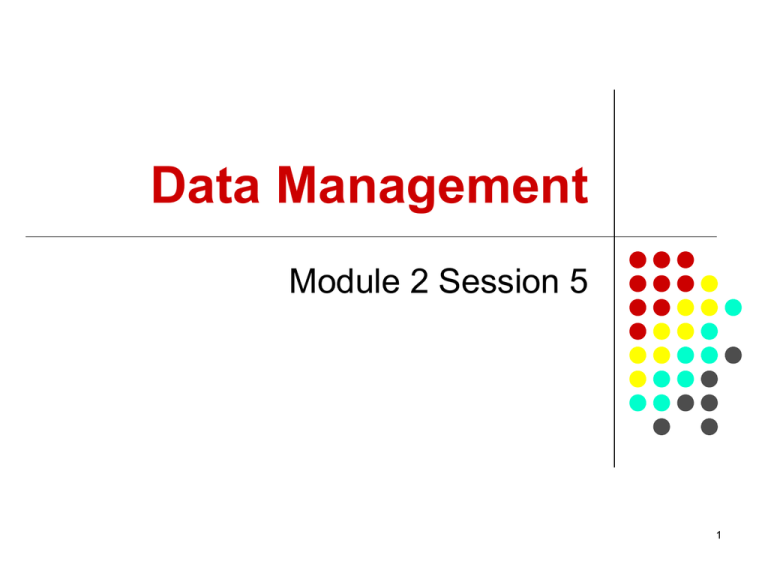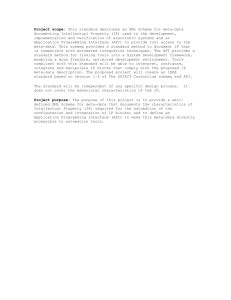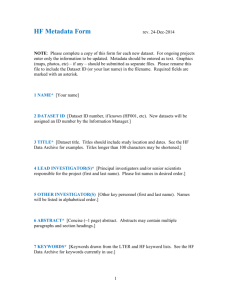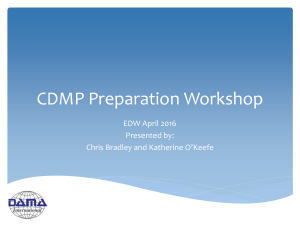Data Management
advertisement

Data Management Module 2 Session 5 1 Overview This session considers the role of Data Management (DM) within the Project Life Cycle It is important to plan effective DM at the project planning stage We show how negligence in DM can results in wrong decisions being made at policy level 2 Objectives To introduce the basic concepts of Data Management To identify the stakeholders in Data Management To outline the stages and levels of Data Danagement To equip participants with skills to manage their data 3 Epi-Info vs MS-Access Epi-Info creates an Access Database file It is easy to learn and easy to use MS-Access is more flexible e.g. in terms of designing data entry screens (show demo) BUT: MS-Access has a steep learning curve Consider engaging an expert for more complex data structures/surveys 4 What is “Data”? Data can be defined as “individual measurements” They are the individual records in a questionnaire They are the “raw materials” in a field or laboratory research activity block 1 1 1 2 2 2 plot 1 2 3 1 2 3 cobwt 17.7 19.9 28.3 26.63 24.88 25.46 grainwt 811 136 172 148 170 158 carbon 2.6 2.54 2.83 2.41 2.39 2.47 5 What is “Meta-data”? Meta-data Is data about the data Describes the dataset Enables effective management of the data resources Allows the dataset to be fully understood Is an essential part of the data documentation So meta-data turns raw data into “information” 6 What is “Information”? Information is processed data from which conclusions can be drawn Information is a valuable resource for decision-making and for planning It is the results of processing, gathering, manipulating and organising data in a way that adds to the knowledge of the receiver 7 What is Data Management? DM is concerned with “looking after” and processing data – it involves: Looking after field data sheets Entering data into computer files Checking and correcting the raw data Preparing data for analysis Documenting and archiving the data and meta-data DM is the consolidation of data (and meta-data) in a way that is easy to manipulate, retrieve and maintain 8 Why is DM important? Ensures data for analysis are of high quality so that conclusions are correct Good DM allows further use of the data in the future and enables efficient integration of results with other studies Good DM leads to : Improved processing efficiency Improved data quality Improved meaningfulness of the data 9 Data Management Problems Lack of skills – inability to use software or set up data checking procedures Multiple copies of files No one with responsibility for checking data No clear policy on archiving or making data available Lack of documentation Multiple entry of the same data Hand pre-processing of data 10 Activity 2 Case Study Discussion In small groups discuss the two examples Have you encountered similar situations in your own workplace? 11 Some steps in DM Designing field data collection sheets Collecting data with appropriate quality control Checking raw data Data entry and organisation of computer files Backup of files Processing of data for analysis Checking of processed data Archiving data and meta-data for future use 12 Project Life Cycle 13 From Problems to Knowledge Formulate (fm) the objectives Develop (dv) the protocol Design (ds) the observation units Collect (coll) the data Compile (cm) data into well-structured datasets Query (qy) to select subsets Analyse (as) the data Publish (pb) the results 14 Scope of Data Management 15 Non-Electronic Data Management Handling of questionnaires in the field (both completed and blank) Storage of questionnaires – protection from weather, termites, etc. Movement of the questionnaires – who has access to them Editing and coding Scanning – is this an option? – Budgetary implications 16 Electronic Data Management Designing data entry system Data entry – including double entry Data cleaning – consistency checks Data security – regular backups – where are backups stored? Storage – how safe is your data? Documentation 17 Documentation Documentation should be part of the project planning: File Structure – how will the data be organised Naming conventions – for files and variables Data integrity – what checks are in place Dataset documentation – how will this be produced Variable construction – what variables will be constructed following data collection; how will these be documented Project documentation – how will you document decisions taken on field procedures, coding, etc. 18 Archiving Many funding agencies now specify that the data be made public at the end of the project Plans for archiving should be included in the project proposal and must be fully costed Proposal should include: Schedule for data sharing Formal of final dataset Documentation to be provided Analytical tools to be provided if any Mode of data sharing 19 Household Survey Archive Data from the Uganda National Household Survey 2002/2003 are available online The online archive was created with the International Household Survey Network Microdata Management Toolkit Either Browse to http://www.ubos.org/ on the web, and follow the link to Survey Documentation Or On the UBOS Resources DVD, browse to drive:/UBOS-UNHC2-CD-image/index.html 20 Online Survey Archive 21 Online Frequency tables 22 Activity 4 In groups discuss the steps involved in data management Identify who commonly undertakes which task in your District Office What does each task involve? What resources – skills, equipment – are needed? How are paper records stored in your workplace? 23 Building a DM Strategy Good DM is not something that will “look after itself” or evolve is left long enough A DM strategy requires: Commitment Skills Time Money 24 Data Management Plan A DM plan will include: Clearly defined roles for staff A regular backup procedure Details of data quality checks Including DM on the agenda of project meetings Procedure for upgrading software Details of how archive is to be produced Details of how the archive is to be maintained For example can you still read 5¼” floppy disks?! 25 Roles and Responsibilities Organisers – handle raw data on a daily basis. They set up data filing systems, enter and check data and maintain data banks Analysers – analyse and interpret data, reducing raw observations to useful information Managers – responsible for providing an enabling environment for the first two groups and ensuring all commitments to stakeholders are met 26 Hints on building a DM strategy Document current procedure Seek consensus Establish a data management forum Standardise – use similar DM plans for all projects Obtain funding – include DM plan in project proposals and budget for it 27 Activity 6 In groups discuss what would be a feasible data management strategy in your workplace 28







